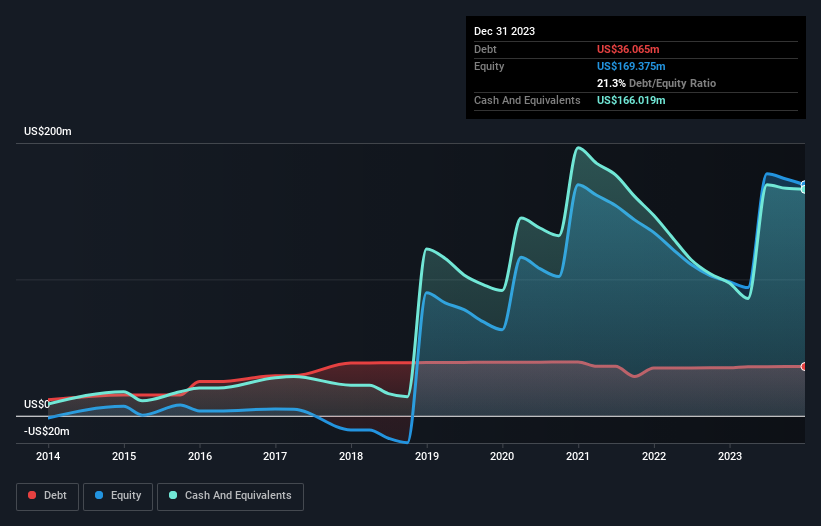Some say volatility, rather than debt, is the best way to think about risk as an investor, but Warren Buffett famously said that 'Volatility is far from synonymous with risk.' So it seems the smart money knows that debt - which is usually involved in bankruptcies - is a very important factor, when you assess how risky a company is. Importantly, SI-BONE, Inc. (NASDAQ:SIBN) does carry debt. But is this debt a concern to shareholders?
What Risk Does Debt Bring?
Debt is a tool to help businesses grow, but if a business is incapable of paying off its lenders, then it exists at their mercy. In the worst case scenario, a company can go bankrupt if it cannot pay its creditors. However, a more frequent (but still costly) occurrence is where a company must issue shares at bargain-basement prices, permanently diluting shareholders, just to shore up its balance sheet. Of course, debt can be an important tool in businesses, particularly capital heavy businesses. When we think about a company's use of debt, we first look at cash and debt together.
See our latest analysis for SI-BONE
What Is SI-BONE's Net Debt?
The chart below, which you can click on for greater detail, shows that SI-BONE had US$36.1m in debt in December 2023; about the same as the year before. But it also has US$166.0m in cash to offset that, meaning it has US$130.0m net cash.

How Strong Is SI-BONE's Balance Sheet?
We can see from the most recent balance sheet that SI-BONE had liabilities of US$23.5m falling due within a year, and liabilities of US$37.6m due beyond that. Offsetting this, it had US$166.0m in cash and US$22.0m in receivables that were due within 12 months. So it can boast US$126.9m more liquid assets than total liabilities.
This surplus suggests that SI-BONE is using debt in a way that is appears to be both safe and conservative. Because it has plenty of assets, it is unlikely to have trouble with its lenders. Succinctly put, SI-BONE boasts net cash, so it's fair to say it does not have a heavy debt load! There's no doubt that we learn most about debt from the balance sheet. But it is future earnings, more than anything, that will determine SI-BONE's ability to maintain a healthy balance sheet going forward. So if you want to see what the professionals think, you might find this free report on analyst profit forecasts to be interesting.
In the last year SI-BONE wasn't profitable at an EBIT level, but managed to grow its revenue by 31%, to US$139m. With any luck the company will be able to grow its way to profitability.
So How Risky Is SI-BONE?
By their very nature companies that are losing money are more risky than those with a long history of profitability. And in the last year SI-BONE had an earnings before interest and tax (EBIT) loss, truth be told. Indeed, in that time it burnt through US$32m of cash and made a loss of US$43m. But the saving grace is the US$130.0m on the balance sheet. That means it could keep spending at its current rate for more than two years. With very solid revenue growth in the last year, SI-BONE may be on a path to profitability. By investing before those profits, shareholders take on more risk in the hope of bigger rewards. There's no doubt that we learn most about debt from the balance sheet. But ultimately, every company can contain risks that exist outside of the balance sheet. We've identified 2 warning signs with SI-BONE , and understanding them should be part of your investment process.
Of course, if you're the type of investor who prefers buying stocks without the burden of debt, then don't hesitate to discover our exclusive list of net cash growth stocks, today.
New: Manage All Your Stock Portfolios in One Place
We've created the ultimate portfolio companion for stock investors, and it's free.
• Connect an unlimited number of Portfolios and see your total in one currency
• Be alerted to new Warning Signs or Risks via email or mobile
• Track the Fair Value of your stocks
Have feedback on this article? Concerned about the content? Get in touch with us directly. Alternatively, email editorial-team (at) simplywallst.com.
This article by Simply Wall St is general in nature. We provide commentary based on historical data and analyst forecasts only using an unbiased methodology and our articles are not intended to be financial advice. It does not constitute a recommendation to buy or sell any stock, and does not take account of your objectives, or your financial situation. We aim to bring you long-term focused analysis driven by fundamental data. Note that our analysis may not factor in the latest price-sensitive company announcements or qualitative material. Simply Wall St has no position in any stocks mentioned.
About NasdaqGM:SIBN
SI-BONE
A medical device company, focuses on solving musculoskeletal disorders of the sacropelvic anatomy in the United States and internationally.
Flawless balance sheet and slightly overvalued.
Similar Companies
Market Insights
Community Narratives



